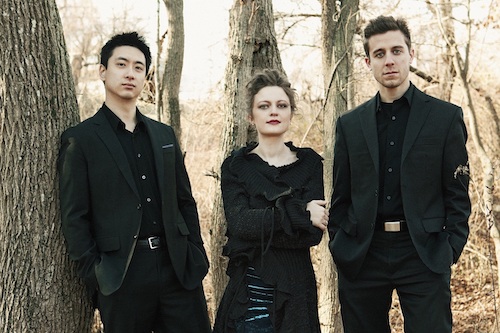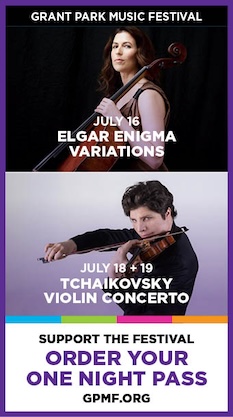Trio Céleste makes impressive Mandel Hall debut
Much has been written about our current golden age of chamber music, an observation easily justified given the plethora of superb young string quartets and risk-taking new music ensembles.
The repertoire for piano trio is smaller than that of the quartet, but far larger than any of the other countless instrumental combinations. A handful of American trios have emerged in recent years, among them the Trio Céleste, an impressive threesome that performed Friday night at Mandel Hall in the University of Chicago Present series.
Violinist Iryna Krechkovsky, cellist Ross Gasworth, and pianist Kevin Kwan Loucks joined forces seven years ago during a reading session at Juilliard. The chemistry was immediate, and soon they were concertizing, winning competitions, and recording, all to considerable acclaim.
The core of the traditional piano trio repertoire is squarely based in the German-speaking world of the late 18th and 19th centuries. But Trio Céleste brought a predominantly Russian program to Mandel Hall with a captivating recent work included for good measure.
There were stylistic commonalities and contrasts aplenty in the program, but all three were inspired in some degree by extramusical considerations, and each ended in somber fadeouts. The considerable technical challenges were expertly tamed for the most part, and the interpretations, if not revelatory, were well considered and, at times, quite moving.
It took a full decade after composition before Pierre Jalbert’s Piano Trio No. 1 finally received its premiere in 2008. At least a few trios have taken up its cause since, and Chicago’s Lincoln Trio made a splendid recording some years back.
The first movement, “Life Cycle,” sounds like a hyperactive scherzo in places, but the abundance of pithy ideas and sharp hairpin turns make it difficult to summarize with a single descriptor. Marked with the performance indication Raw, aggressive, it is uncompromising in its modernity, but Jalbert supplies plenty of hooks to keep the ear anxiously engaged.
While dissonance is dished out liberally, the meter is often clear, sometimes underlined with pulsing, syncopated ostinati borrowed from the Stravinsky playbook. The clever combination of low cello pizzicatos and plucked piano strings elevated this device above a cliché. There are stray hints of klezmer in some melodic patterns, and one particularly raucous section presents a single run of a blues progression, heavily medicated and barely recognizable.
Occasional moments of repose were sparsely scored by Jalbert, with an ambiguous motto chord and hushed lyrical string interruptions in whistling artificial harmonics. The contrasts were expertly negotiated by the trio, and the final, brutal hammer chords made for an aptly violent conclusion.
The second and final movement, “Agnus Dei,” is dedicated to the life and work of Mother Theresa, and the contemplative aura of this performance fairly glowed with the sprit of Messiaen. The use of mutes gave the lyrical utterances a distant quality as the trio let the music unfold with patience and dignity.
Chamber music with strings and piano reached a peak in the 19th century, but the medium wasn’t a favorite of Tchaikovsky. His single work in the genre was the Piano Trio in A minor, and, unlike the other two works in the program, came late in his life.
The work is cast in only two movements, but each far exceeds standard length. Critics have decried the composer’s looseness of form in the first movement, but the richness of the melodic material and his idiomatic command of strings and keyboard make for an engrossing journey, especially in such committed hands.
The titanic piano part presents nightmarish balance issues, but the trio made just enough sensible compromises to allow primary material to always surface. Krechkovsky wasn’t afraid to lay on a hefty dose of schmalz (via portamentos) more typical of bygone eras, and Gasworth was nearly as emphatic in his expressive declarations of the composer’s sumptuous tunes.
The final theme and variations showed a few cracks in the group’s veneer of technical perfection, yet the movement was in many respects the highlight of the concert. Loucks’ opening tune was elegant and understated, but clarity waned a bit when tempos were overly ambitious. The sleigh bell variation sounded more like the Kentucky Derby than a leisurely ride through the snowy Russian countryside.
The odd slip in intonation notwithstanding, the strings dove into the score with feverish intensity. The final fragments of the opening theme were tenderly restrained as Loucks intoned a muted funeral march in the piano’s lower register.
Rachmaninoff wrote two pianos trios in his late teens in quick succession, both with the subtitle “Trio élégiaque.” The second was explicitly dedicated to the memory of Tchaikovsky, but it is generally assumed that the first was also inspired by the Russian master as well as Rachmaninoff’s mentor, Nikolai Rubinstein.
Trio Céleste chose the first for this program, a single movement work marked Lento legubre in the opening bars. The centrality of the piano was clear at the outset, and Loucks lovingly molded the theme over gentle murmurs in the strings. A closing connection to the Tchaikovsky is the final version of the theme, transformed as another funeral march, and poignantly delivered as a solemn hymn by Gasworth and Krechkovsky.
Posted in Uncategorized



